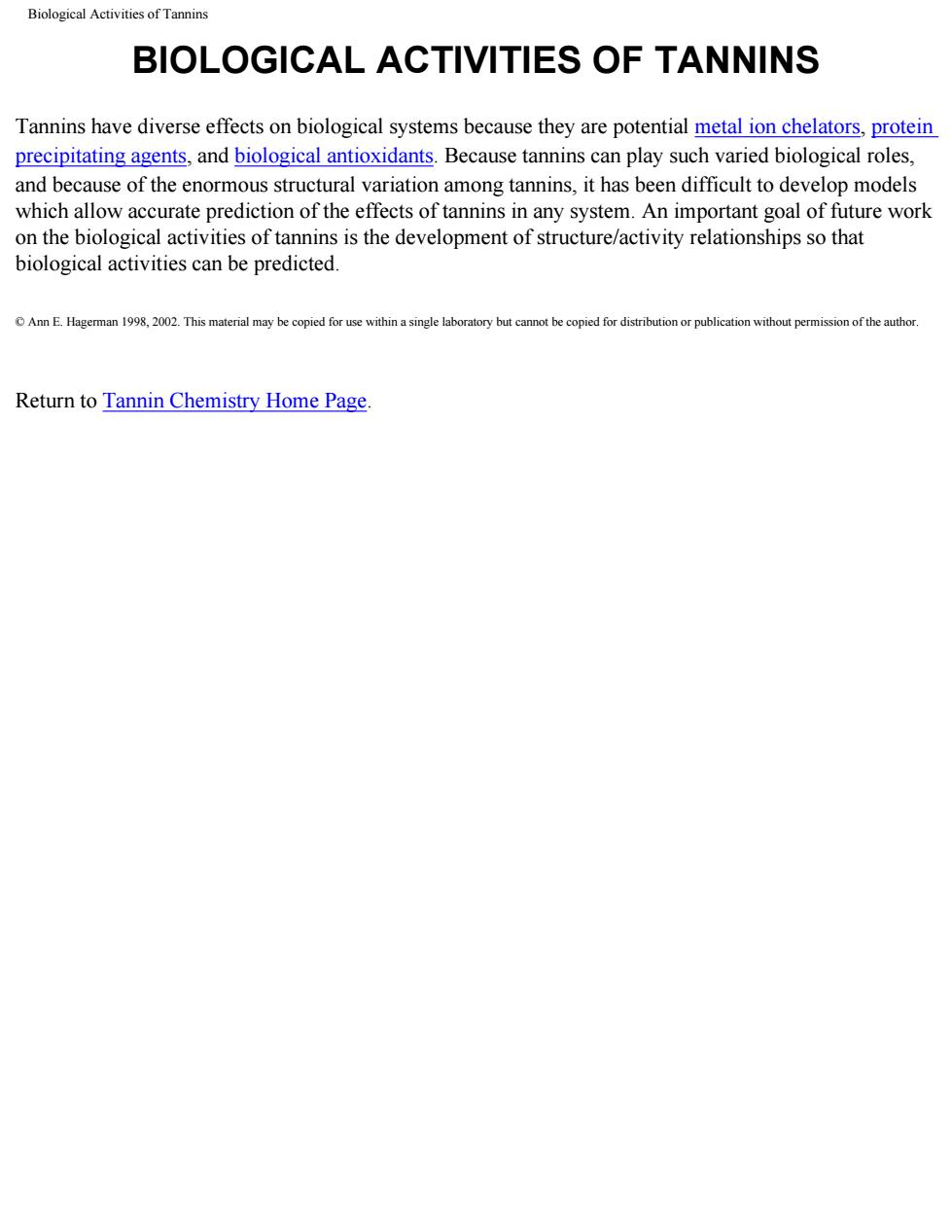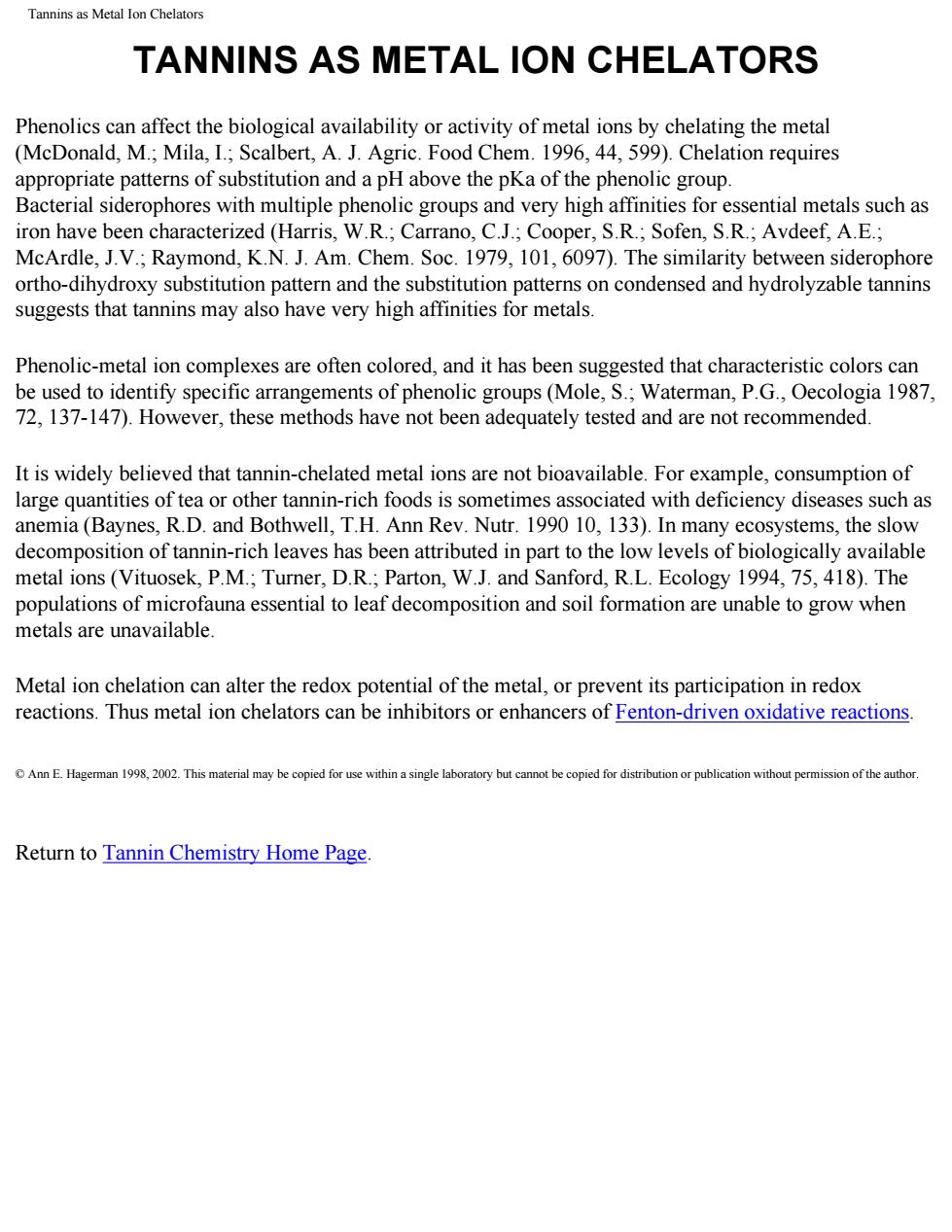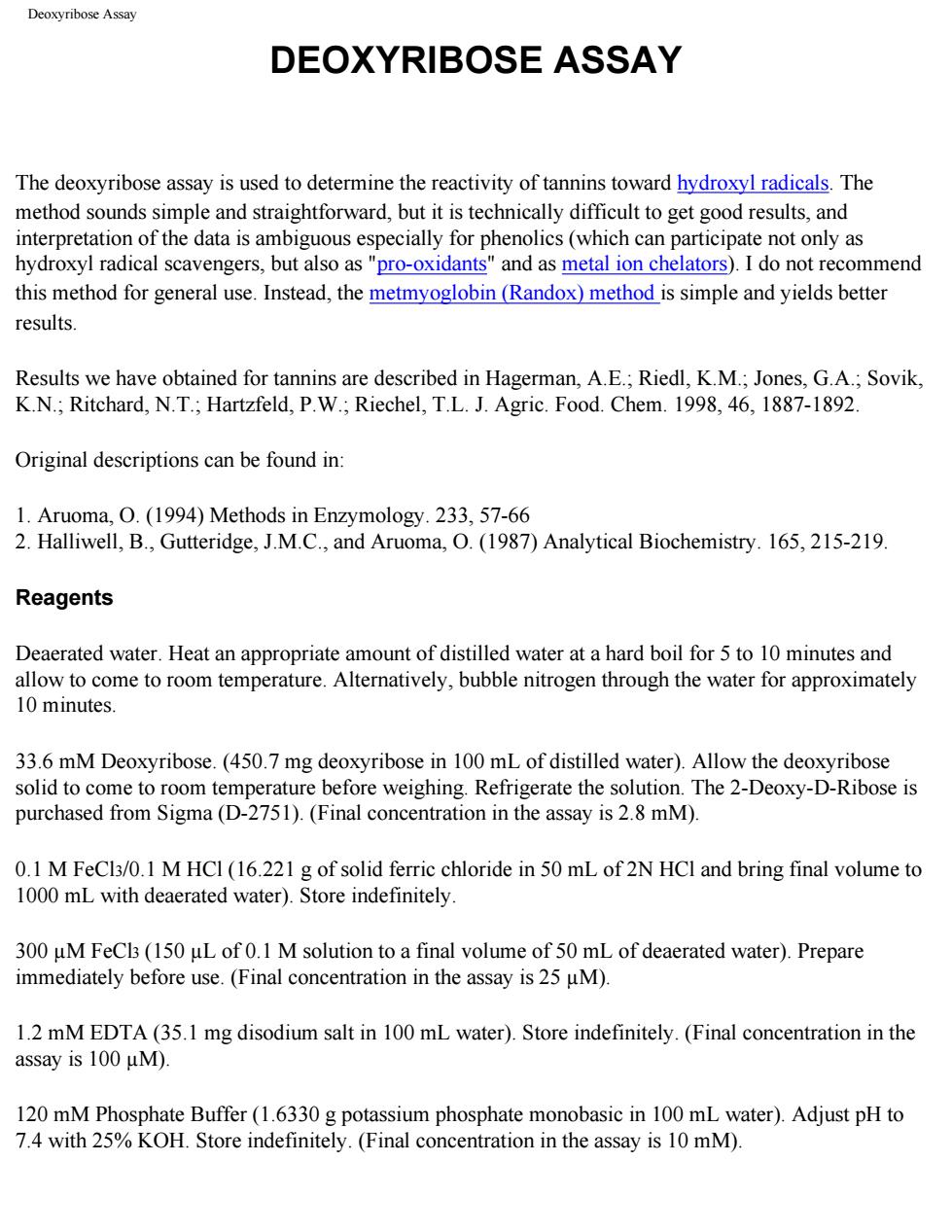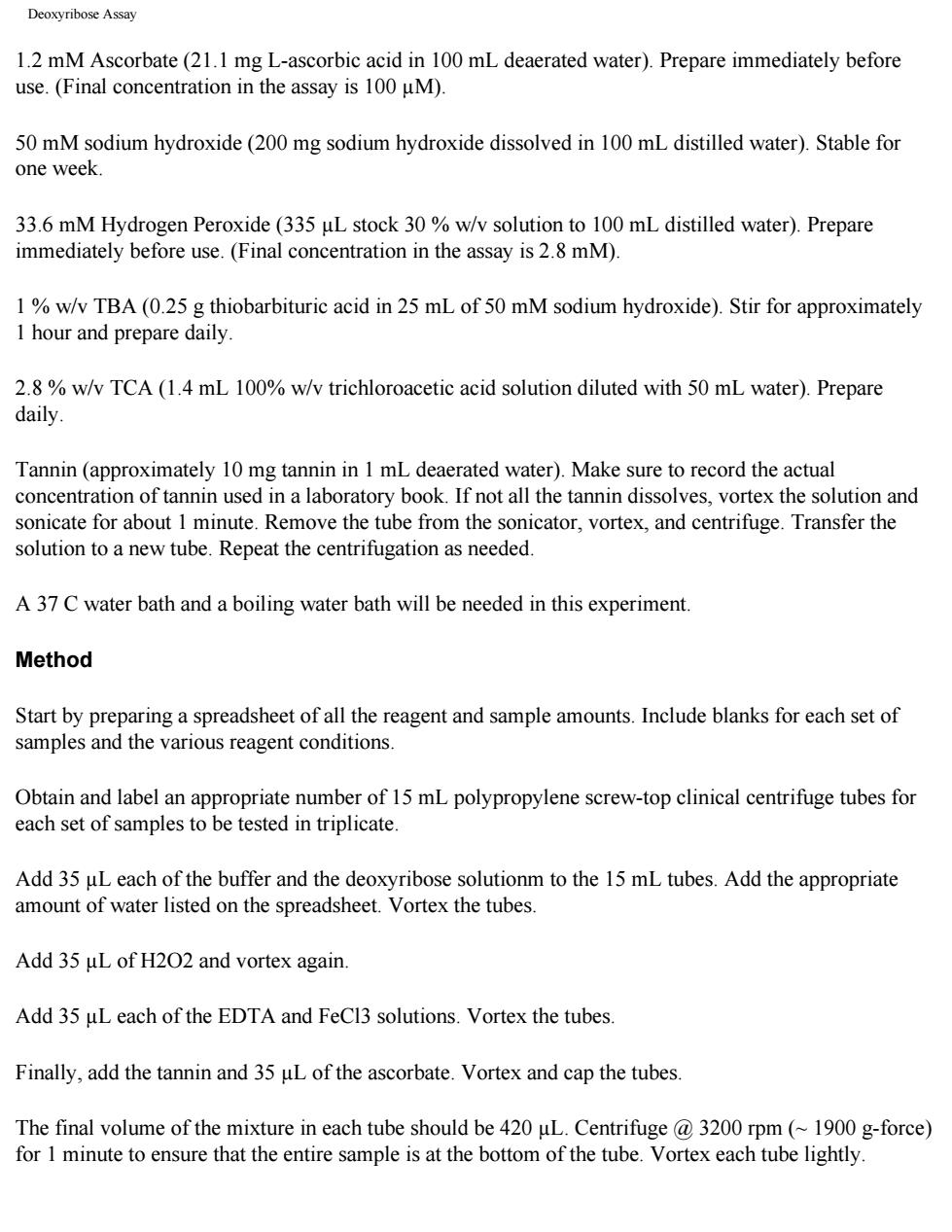
man hydrolyzable tannin structural chemistry 多 OH HO 8 0 0 0 OH OH HO 0 OH G OH HO 0 0 OH HO HO OH 0 o 0 8H 0 OH OH oenethein B n1998,2002.This erial miay be copied fo opiedfordistributiono Return to Tannin Chemistry Home Page
Hagerman hydrolyzable tannin structural chemistry 7/7 © Ann E. Hagerman 1998, 2002. This material may be copied for use within a single laboratory but cannot be copied for distribution or publication without permission of the author. Return to Tannin Chemistry Home Page O O G O O O O O O O OH OH OH OH OH OH OH O OH O O O O O O O O OH HO HO HO HO HO HO OH HO OH G oenethein B

Biological Activities of Tannins BIOLOGICAL ACTIVITIES OF TANNINS Tannins have diverse effects on biological systems because they are potential metal ion chelators,protein precipitating agents,and biological antioxidants.Because tannins can play such varied biological roles, and because of the enormous structural variation among tannins,it has been difficult to develop models which allow accurate prediction of the effects of tannins in any system.An important goal of future work on the biological activities of tannins is the development of structure/activity relationships so that biological activities can be predicted. Return to Tannin Chemistry Home Page
Biological Activities of Tannins BIOLOGICAL ACTIVITIES OF TANNINS Tannins have diverse effects on biological systems because they are potential metal ion chelators, protein precipitating agents, and biological antioxidants. Because tannins can play such varied biological roles, and because of the enormous structural variation among tannins, it has been difficult to develop models which allow accurate prediction of the effects of tannins in any system. An important goal of future work on the biological activities of tannins is the development of structure/activity relationships so that biological activities can be predicted. © Ann E. Hagerman 1998, 2002. This material may be copied for use within a single laboratory but cannot be copied for distribution or publication without permission of the author. Return to Tannin Chemistry Home Page

Tannins a Metal on Chelators TANNINS AS METAL ION CHELATORS Phenolics can affect the biological availability or activity of metal ions by chelating the metal (McDonald,M.;Mila,I.;Scalbert,A.J.Agric.Food Chem.1996,44,599).Chelation requires appropriate patterns of substitution and a pH above the pKa of the phenolic group. Bacterial siderophores with multiple phenolic groups and very high affinities for essential metals such as iron have been characterized (Harris,W.R.;Carrano,C.J.;Cooper,S.R.;Sofen,S.R.;Avdeef,A.E.; McArdle,J.V.;Raymond,K.N.J.Am.Chem.Soc.1979,101,6097).The similarity between siderophore ortho-dihydroxy substitution pattern and the substitution patterns on condensed and hydrolyzable tannins suggests that tannins may also have very high affinities for metals. Phenolic-metal ion complexes are often colored,and it has been suggested that characteristic colors can be used to identify specific arrangements of phenolic groups (Mole.Waterman,PGOecologa1987 72,137-147).However,these methods have not been adequately tested and are not recommended. It is widely believed that tannin-chelated metal ions are not bioavailable.For example,consumption of large quantities of tea or other tannin-rich foods is sometimes associated with deficiency diseases such as anemia(Baynes,R.D.and Bothwell,T.H.Ann Rev.Nutr.1990 10,133).In many ecosystems,the slow decomposition of tannin-rich leaves has been attributed in part to the low levels of biologically available metal ions(Vituosek,P.M.;Turner,D.R.;Parton,W.J.and Sanford,R.L.Ecology 1994,75,418).The populations of microfauna essential to leaf decomposition and soil formation are unable to grow when metals are unavailable. Metal ion chelation can alter the redox potential of the metal,or prevent its participation in redox reactions.Thus metal ion chelators can be inhibitors or enhancers of Fenton-driven oxidative reactions An E Hageman 9.2002.This material may be coped forusewithinasingle laboratory but cannot be copied for distributono publication without permission of the author. Return to Tannin Chemistry Home Page
Tannins as Metal Ion Chelators TANNINS AS METAL ION CHELATORS Phenolics can affect the biological availability or activity of metal ions by chelating the metal (McDonald, M.; Mila, I.; Scalbert, A. J. Agric. Food Chem. 1996, 44, 599). Chelation requires appropriate patterns of substitution and a pH above the pKa of the phenolic group. Bacterial siderophores with multiple phenolic groups and very high affinities for essential metals such as iron have been characterized (Harris, W.R.; Carrano, C.J.; Cooper, S.R.; Sofen, S.R.; Avdeef, A.E.; McArdle, J.V.; Raymond, K.N. J. Am. Chem. Soc. 1979, 101, 6097). The similarity between siderophore ortho-dihydroxy substitution pattern and the substitution patterns on condensed and hydrolyzable tannins suggests that tannins may also have very high affinities for metals. Phenolic-metal ion complexes are often colored, and it has been suggested that characteristic colors can be used to identify specific arrangements of phenolic groups (Mole, S.; Waterman, P.G., Oecologia 1987, 72, 137-147). However, these methods have not been adequately tested and are not recommended. It is widely believed that tannin-chelated metal ions are not bioavailable. For example, consumption of large quantities of tea or other tannin-rich foods is sometimes associated with deficiency diseases such as anemia (Baynes, R.D. and Bothwell, T.H. Ann Rev. Nutr. 1990 10, 133). In many ecosystems, the slow decomposition of tannin-rich leaves has been attributed in part to the low levels of biologically available metal ions (Vituosek, P.M.; Turner, D.R.; Parton, W.J. and Sanford, R.L. Ecology 1994, 75, 418). The populations of microfauna essential to leaf decomposition and soil formation are unable to grow when metals are unavailable. Metal ion chelation can alter the redox potential of the metal, or prevent its participation in redox reactions. Thus metal ion chelators can be inhibitors or enhancers of Fenton-driven oxidative reactions. © Ann E. Hagerman 1998, 2002. This material may be copied for use within a single laboratory but cannot be copied for distribution or publication without permission of the author. Return to Tannin Chemistry Home Page

Deowvrihose Assav DEOXYRIBOSE ASSAY The deoxyribose assay is used to determine the reactivity of tannins toward hydroxyl radicals.The method sounds simple and straightforward,but it is technically difficult to get good results,and interpretation of the data is ambiguous especially for phenolics(which can participate not only as hydroxyl radical scavengers,but also as"pro-oxidants"and as metal ion chelators).I do not recommend this method for general use.Instead,the metmyoglobin (Randox)method is simple and yields better results. Results we have obtained for tannins are described in Hagerman,A.E.;Riedl,K.M.:Jones,G.A.;Sovik. K.N.;Ritchard,N.T.;Hartzfeld,P.W.;Riechel,T.L.J.Agric.Food.Chem.1998,46,1887-1892 Original descriptions can be found in: 1.Aruoma,O.(1994)Methods in Enzymology.233,57-66 2.Halliwell,B.Gutteridge,J.M.C.and Aruoma,.(1987)Analytical Biochemistry.165,215-219. Reagents Deaerated water.Heat an appropriate amount of distilled water at a hard boil for 5 to 10 minutes and allow to come to room temperature.Alternatively,bubble nitrogen through the water for approximately 10 minutes 33.6 mM Deoxyribose.(450.7 mg deoxyribose in 100 mL of distilled water).Allow the deoxyribose solid to come toroom temperature before weighing.Refrigerate the solution.The 2-Deoxy-D-Ribose is purchased from Sigma(D-2751).(Final concentration in the assay is 2.8 mM) 0.1 M FeCl3/0.1 M HCI(16.221 g of solid ferric chloride in 50 mL of 2N HCI and bring final volume to 1000 mL with deaerated water).Store indefinitely 300 uM FeCl3(150 uL of 0.1 M solution to a final volume of 50 mL of deaerated water).Prepare immediately before use.(Final concentration in the assay is 25 uM). 1.2 mM EDTA(35.1 mg disodium salt in 100 mL water).Store indefinitely.(Final concentration in the assay is 1000μM) 5osgc3的nOk》tApH
Deoxyribose Assay DEOXYRIBOSE ASSAY The deoxyribose assay is used to determine the reactivity of tannins toward hydroxyl radicals. The method sounds simple and straightforward, but it is technically difficult to get good results, and interpretation of the data is ambiguous especially for phenolics (which can participate not only as hydroxyl radical scavengers, but also as "pro-oxidants" and as metal ion chelators). I do not recommend this method for general use. Instead, the metmyoglobin (Randox) method is simple and yields better results. Results we have obtained for tannins are described in Hagerman, A.E.; Riedl, K.M.; Jones, G.A.; Sovik, K.N.; Ritchard, N.T.; Hartzfeld, P.W.; Riechel, T.L. J. Agric. Food. Chem. 1998, 46, 1887-1892. Original descriptions can be found in: 1. Aruoma, O. (1994) Methods in Enzymology. 233, 57-66 2. Halliwell, B., Gutteridge, J.M.C., and Aruoma, O. (1987) Analytical Biochemistry. 165, 215-219. Reagents Deaerated water. Heat an appropriate amount of distilled water at a hard boil for 5 to 10 minutes and allow to come to room temperature. Alternatively, bubble nitrogen through the water for approximately 10 minutes. 33.6 mM Deoxyribose. (450.7 mg deoxyribose in 100 mL of distilled water). Allow the deoxyribose solid to come to room temperature before weighing. Refrigerate the solution. The 2-Deoxy-D-Ribose is purchased from Sigma (D-2751). (Final concentration in the assay is 2.8 mM). 0.1 M FeCl3/0.1 M HCl (16.221 g of solid ferric chloride in 50 mL of 2N HCl and bring final volume to 1000 mL with deaerated water). Store indefinitely. 300 µM FeCl3 (150 µL of 0.1 M solution to a final volume of 50 mL of deaerated water). Prepare immediately before use. (Final concentration in the assay is 25 µM). 1.2 mM EDTA (35.1 mg disodium salt in 100 mL water). Store indefinitely. (Final concentration in the assay is 100 µM). 120 mM Phosphate Buffer (1.6330 g potassium phosphate monobasic in 100 mL water). Adjust pH to 7.4 with 25% KOH. Store indefinitely. (Final concentration in the assay is 10 mM)

Deoxyribose Assay 1.2 mM Ascorbate(21.1 mg L-ascorbic acid in 100 mL deaerated water).Prepare immediately before use.(Final concentration in the assay is 100 uM). 50 mM sodium hydroxide(200 mg sodium hydroxide dissolved in 100 mL distilled water).Stable for one week. 33.6 mM Hydrogen Peroxide (335 uL stock 30%w/v solution to 100 mL distilled water).Prepare immediately before use.(Final concentration in the assay is 2.8 mM). 1%w/v TBA(0.25 g thiobarbituric acid in 25 mL of 50 mM sodium hydroxide).Stir for approximately 1 hour and prepare daily. 2.8%w/v TCA(1.4 mL 100%w/v trichloroacetic acid solution diluted with 50 mL water).Prepare daily. Tannin (approximately 10 mg tannin in 1 mL deaerated water).Make sure to record the actual concentration of tannin used in a laboratory book.If not all the tannin dissolves,vortex the solution and sonicate for about 1 minute.Remove the tube from the sonicator,vortex,and centrifuge.Transfer the solution to a new tube.Repeat the centrifugation as needed A 37 C water bath and a boiling water bath will be needed in this experiment. Method Start by preparing a spreadsheet of all the reagent and sample amounts.Include blanks for each set of samples and the various reagent conditions. Obtain and label an appropriate number of 15 mL polypropylene screw-top clinical centrifuge tubes for each set of samples to be tested in triplicate. Add 35 uL each of the buffer and the deoxyribose solutionm to the 15 mL tubes.Add the appropriate amount of water listed on the spreadsheet.Vortex the tubes. Add 35 uL of H202 and vortex again. Add 35 uL each of the EDTA and FeCl3 solutions.Vortex the tubes Finally,add the tannin and 35 uL of the ascorbate.Vortex and cap the tubes The final volume of the mixture in each tube should be 420 uL.Centrifuge 3200 rpm(~1900 g-force) for 1 minute to ensure that the entire sample is at the bottom of the tube.Vortex each tube lightly
Deoxyribose Assay 1.2 mM Ascorbate (21.1 mg L-ascorbic acid in 100 mL deaerated water). Prepare immediately before use. (Final concentration in the assay is 100 µM). 50 mM sodium hydroxide (200 mg sodium hydroxide dissolved in 100 mL distilled water). Stable for one week. 33.6 mM Hydrogen Peroxide (335 µL stock 30 % w/v solution to 100 mL distilled water). Prepare immediately before use. (Final concentration in the assay is 2.8 mM). 1 % w/v TBA (0.25 g thiobarbituric acid in 25 mL of 50 mM sodium hydroxide). Stir for approximately 1 hour and prepare daily. 2.8 % w/v TCA (1.4 mL 100% w/v trichloroacetic acid solution diluted with 50 mL water). Prepare daily. Tannin (approximately 10 mg tannin in 1 mL deaerated water). Make sure to record the actual concentration of tannin used in a laboratory book. If not all the tannin dissolves, vortex the solution and sonicate for about 1 minute. Remove the tube from the sonicator, vortex, and centrifuge. Transfer the solution to a new tube. Repeat the centrifugation as needed. A 37 C water bath and a boiling water bath will be needed in this experiment. Method Start by preparing a spreadsheet of all the reagent and sample amounts. Include blanks for each set of samples and the various reagent conditions. Obtain and label an appropriate number of 15 mL polypropylene screw-top clinical centrifuge tubes for each set of samples to be tested in triplicate. Add 35 µL each of the buffer and the deoxyribose solutionm to the 15 mL tubes. Add the appropriate amount of water listed on the spreadsheet. Vortex the tubes. Add 35 µL of H2O2 and vortex again. Add 35 µL each of the EDTA and FeCl3 solutions. Vortex the tubes. Finally, add the tannin and 35 µL of the ascorbate. Vortex and cap the tubes. The final volume of the mixture in each tube should be 420 µL. Centrifuge @ 3200 rpm (~ 1900 g-force) for 1 minute to ensure that the entire sample is at the bottom of the tube. Vortex each tube lightly